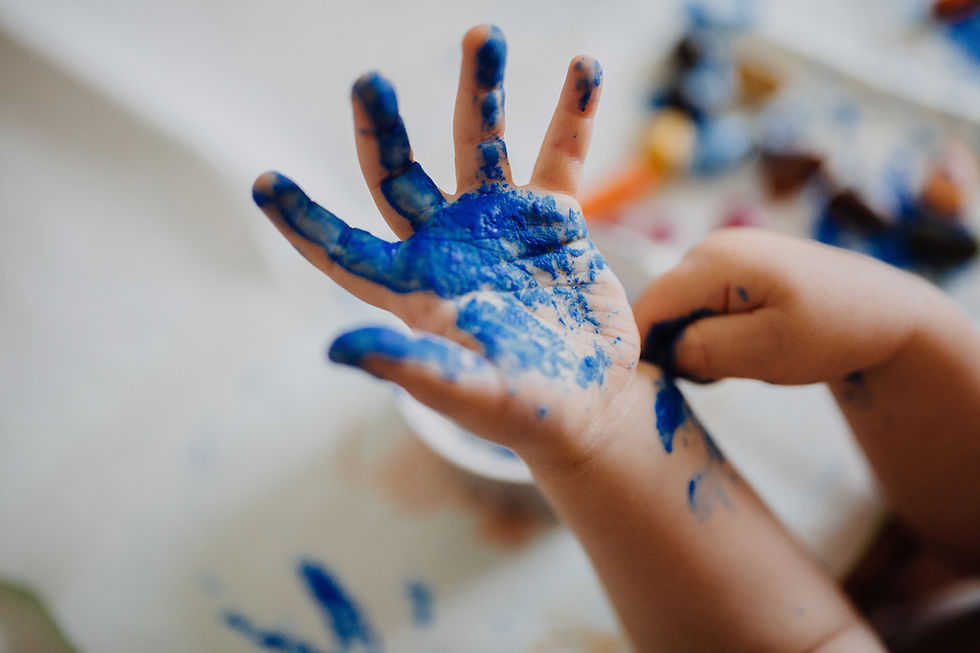Art therapy is a gentle yet transformative approach that can significantly reduce anxiety, improve emotional regulation, enhance resilience and create lasting positive change. Creative expression offers a natural, non-threatening way to express complex emotions, work through challenging experiences and foster developmental growth.
Art and creativity can become a communicative tool for meaningful conversations, healthy emotional processing and healing attachment with caregivers as well as connections with family members.

-Build emotional vocabulary and literacy
-Process traumatic and somatic memories
-Soothe the nervous system
-Improve impulse control and self regulation
-Engage sensory processing and integration
-Promote social skills learning
-Support psychomotor development
-Sensory processing and social participation
-Soothing the body, brain and mind
-Plasticity and motor coordination
-Identity exploration and self esteem
-Widening threshold tolerance
-Relational and adaptive functioning
-Explore healthy coping skills


-Parent recovering from their own early childhood adversity
-Navigating difficult life experiences
-Attuning and fostering attachment
-Parent and child dyad therapy
-Ancestral and family trauma
-Adoption, foster care
-Communication and boundaries
-Support plan development
Art therapy
Support for both child and parent
.Working with children's attachment with security and resiliency
.Building identity and confidence with play and art
.Supporting parents and deliberate dialogue
.Recovering from generational trauma
.Fostering fulfilling family relationships
During your child's appointment
She/he is given a tour of the playroom and orientated to the different choices and methods of expression. Our playroom hosts many therapeutic options, some of which include:
-
Sandtray
-
Dollhouse
-
Children’s therapeutic books
-
Collection of puppets and dolls.
-
Natural wooden toys
-
Games
The playroom is a special place for children where non-directive art and sensory play unfolds and provides them with opportunities to create a window for the therapist to witness their lived experience and the conflicts that may be felt or perceived by them. We understand that the safety and quality of the therapeutic relationship with the therapist is a key ingredient to obtain successful therapeutic outcomes.
Emotion, thoughts, memories and choices the child encounters in daily life are revealed through sensory play and creativity. This therapeutic modality allows children the ability to explore self-acceptance, safety in the world, closure & healing. Children often work silently and welcome this modality because it is gentle and responsive to their natural mode of being.

Art therapy can offer opportunities to communicate in non verbal ways and is able to invite deliberate dialogue to serve safety, connection and attachment.
Art therapy can support multiple levels of functioning in generating a stimulating and nurturing environment and individualized art interventions to help each child express themselves. Creative outlets can help one develop socially and emotionally with the joy of art experiences.
Art and Sensory play can support children in various domains of development such as physical, cognitive, socio emotional and language.
Creative art and sandplay experiences help with developing curiosity, focus and mindfulness which benefits with treatment goals related to behaviour, communication, learning, coping skills, relationship, agency, empowerment. It's a therapeutic approach that helps children with psychomotor learning, socio relational skills, emotional intelligence, healthy sensory processing and executive function.
Somatic mindfulness offers ways to address the mental emotional components of trauma in a safe, compassionate and nurturing environment. Psychosomatic concerns can cause issues such as physical pain, sleep issues/nightmares, fatigue, irritability, opposition and intrusive thoughts.
Inviting mind, body and emotions sensations together in a therapeutic way can encourage psychological and emotional healing from early adverse experiences such as trauma.
Our process ensures that we follow best practices for each child and their families, every single time. Although we follow a standard process, the help and care that your child receives will be as unique as they are.
It begins with a conversation. You schedule your initial appointment with a therapist. This first appointment may be a consultation where we collect relevant history and the details related to your most pressing concerns to inform next steps and recommendations.

